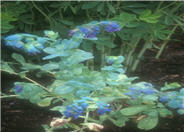
Common name:Deer Grass
Botanical name:Muhlenbergia rigens
The deer grass is a warm season perennial that forms dense clumps from the base. The spike like flower stalks grow 2-3 ft. tall and this grass has striking foundation form. The deer grass is native to California, is drought tolerant, and is a beneficial insect plant. -Cornflower Farms

Common name:Wulfen Euphorbia
Botanical name:Euphorbia characias wulfenii
This perennial will reach about 4' tall and has significant green leaves with clusters of yellow flowers.

Common name:Iris 'Canyon Snow'
Botanical name:Iris Pacific Coast Hybrid 'Canyon Snow'
Iris 'Canyon Snow' is a beautifu, white flower with a yellow throat. It is one of the best performing of the hybrid native irises. It tolerates regular garden conditions and does not struggle through the summer. Virtually no mortality issues at all. Very little to no maintenance once established. Like most Irises, the bloom period is fairly short. Best used in mass plantings. Prefers partial to full shade.

Common name:Golden Bamboo, Fish Pole Bamboo
Botanical name:Phyllostachys aurea
This bamboo will grow to about 25' tall and is drought tolerant with dense foliage. This running bamboo needs to be restricted or confined. Possible risk in riparian areas.

Common name:Honeywort
Botanical name:Cerinthe major
This annual can grow 15-60cm high and produces yellow blooms.

Common name:Red Paintbrush Grass
Botanical name:Pennisetum messiacum
The clumping Pennisetum is most effectively used in mass plantings where the dark, almost black flowers can wave in the wind. Although originally thought to be an evergreen, it goes semi-dormant in most climates in Southern CA. Requires moderate water through the summer. Grows to 2' tall and 2' wide. Should be cut back annually to promote fresh growth. Should not be planted near natural areas.

Common name:Little Bunny Fountain Grass
Botanical name:Pennisetum alopecuroides 'Little Bunny'
This perennial grass will grow 1.5' tall and 1.5' wide. It has bright green foliage with pinkish flowers that bloom in summer and fall.
| Designer: 2660 E Lake Ave., Watsonville | Modern Sculptures |
Photographer: GardenSoft |
Soils and Compost:
Physical weed control, including mulching, or hand removal protects the watershed from harmful chemicals.
Water Saving Tip:
Apply a 2-3 inch layer of mulch in planting beds to conserve water, suppress weeds, and protect the soil from compaction and erosion.
Integrated Pest Management:
Develop healthy soil for plants that are vigorous and naturally pest-resistant.

